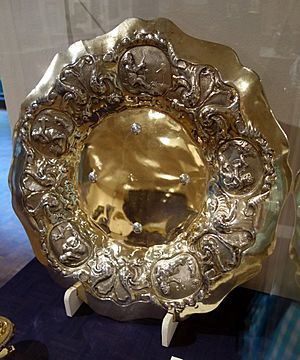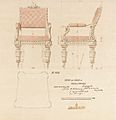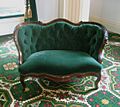Rococo Revival facts for kids

The Rococo Revival style was a popular art and design trend in the 1800s. It brought back the fancy, flowing look of the original rococo style from the 1700s. This revival happened across Europe, especially in France and England. You could see it in many things like decorations, paintings, furniture, and interior design.
For many people, especially in France, the original rococo style was a symbol of their country's history. So, bringing it back felt like honoring national traditions. Rococo Revival showed off luxury and grand European style. It also connected to the 19th century's love for romanticism and nature.
Later in the 1800s, Rococo Revival became popular in American furniture and home design too. John Henry Belter was a very famous furniture maker known for this style. The Rococo Revival wasn't just a short trend. It came back in different waves throughout the 19th century.
Contents
What is Rococo?
The word "Rococo" describes an art style from the early 1700s, mostly in France. It started as a way to decorate homes and quickly became the main art style in Europe. Interestingly, the word "rococo" itself wasn't used until after the French Revolution.
Rococo style is known for its curvy lines and detailed decorations. It often featured playful and natural designs. Think of fancy, detailed ornaments that look luxurious and rich. Later, when a new style called neoclassicism came along, "rococo" was sometimes used to criticize older, more ornate art.
Louis XV's Influence
In the mid-1800s, when people talked about "rococo," they often meant the designs from the time of Louis XV and early Louis XVI. The period from 1715 to 1745, during Louis XV's rule, is seen as the peak of the original Rococo style in French art.
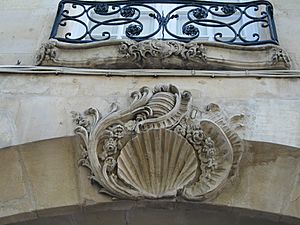
Where the Name Came From
The name "Rococo" likely comes from two French words. One is rocaille, which means fancy, uneven rockwork used in gardens and fountains. The other is coquillage, which means shell designs that often went with the rockwork. Some also think it might combine rocaille with the Italian word barocco, meaning something misshapen or complex.
Rococo Revival in England
During the Regency era (1811-1830), the Prince Regent (who later became King George IV) loved high-quality rococo silver. His taste helped make the rococo revival popular in England. He preferred fancy versions of the late Louis XV and Louis XVI styles.
Paul Storr was a very famous English silversmith. He was known for his excellent work and ability to create many different styles. Many of his pieces featured rococo designs. For example, he made a large candelabrum with flowing branches and curved surfaces.
In the late 1820s, rich families started asking for non-classical styles. This led to a different kind of rococo in England. Factories in Birmingham and Sheffield began mass-producing "Sheffield plate". This was a cheaper material made of silver and copper layers. Machines could easily press rococo designs like scrolls and flowers onto thin silver. This meant that fancy silver items, once only for royalty, became available to more people.
In Paris, designers made metal items called ormolu, which were bronze covered in gold. These were popular with Napoleon III and his wife Eugénie. They wanted their court to look as grand as the old French kings, like Louis XV.
Rococo Revival in France
Louis Philippe's Era (1830-1848)
During the time of King Louis Philippe, a new wealthy middle class (the bourgeoisie) grew in France. These families wanted rococo decorations and furniture. They bought these items to show off their status and wealth. Rococo was popular because it reminded people of a time of luxury and grandeur.
French Rococo furniture from this period was light, elegant, and graceful. It had delicate leaves and complex details. Other features included detailed carvings of flowers and fruits. The furniture also had curved frames and soft, tufted seats.
Second Empire (1852-1870)
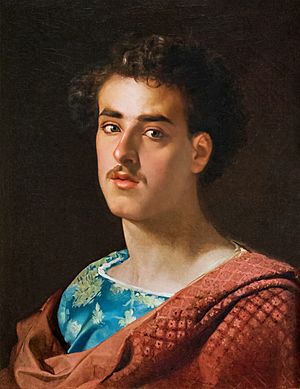
During the Second Empire, many Italian artists came to Paris looking for work. Paris was the place to be for modern art. These artists started painting in the popular rococo revival style of the 1700s. One of the most famous was Mariano Fortuny.
Fortuny's paintings reminded people of 18th-century artists like Antoine Watteau and Jean-Honoré Fragonard. Rich art buyers during the late Second Empire especially liked Fortuny's revival of 18th-century genre painting (scenes from everyday life).
Fortuny's rococo-style art was very popular with the French. It showed a happy view of life and fit well with the new wealthy class in Paris. The government also liked rococo art. They used it to connect themselves to the old royal times of Louis XV. This helped them seem more powerful and respected.
However, not everyone liked this new art. Some critics thought the rococo revival by Italian artists was not very good. They felt it was empty and lacked true style.
Third Republic (1870-1940)
After losing the Franco-Prussian War, France wanted to rebuild its national pride. So, in the late 1800s, the French government heavily promoted the rococo style. It was a way to bring back a sense of national heritage and pride.
The Second Rococo in Austria and Hungary
In Austria and Hungary, the return of the Rococo style was called the "second Rococo." You could see it in art and home furnishings, especially in paintings. At an industrial exhibition in 1845, a whole room was decorated in Rococo style. This fancy room, called "Kaiser Salon," was seen as a new and exciting trend.
The second Rococo was a result of Austria's growing industry and new middle class. It appeared during a time of economic growth in the early 1800s. This style was well-received at industrial exhibitions that promoted Austrian products.
John Henry Belter and American Rococo Furniture
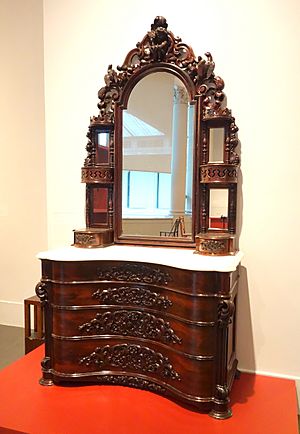
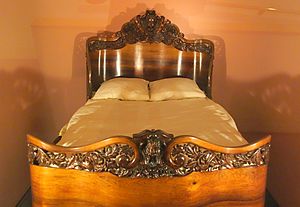
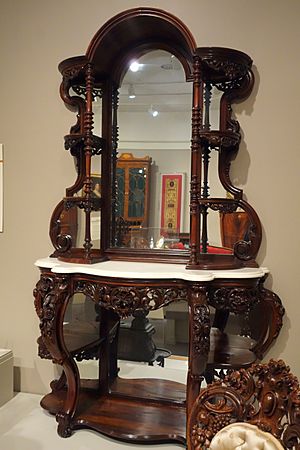
John Henry Belter (1804-1863) was a very famous American furniture maker. He was so well-known that his name was often used for all Rococo Revival furniture. People who bought fancy furniture in the mid-1800s loved Rosewood from Brazil and East India.
Rosewood is beautiful but also very hard and brittle. This meant rosewood furniture could break easily. Belter found a clever solution to this problem.
He patented a way to make laminated furniture. This involved gluing many thin sheets of wood together with hot glue. Then, he would bend these glued sheets using steam and press them into molds. After that, he would carve them. This process made stronger furniture that was also cheaper to make than traditional carved pieces. It also allowed for mass production.
Furniture made this way was thinner and lighter than solid wood. It was also just as strong and less likely to break. Belter could create very detailed designs without needing to cut holes all the way through the wood.
Belter's Rococo style often included designs from the 1600s. The carvings on 18th-century Rococo furniture were simpler. But the carvings on 19th-century revival pieces were much more detailed and clear.
Images for kids
-
Rococo Revival Chair (c.1858), Vermont Statehouse, Montpelier, Vermont.
-
Rococo Revival Settee (c. 1859), by Blake & Davenport, Vermont Statehouse, Montpelier, Vermont.
-
Rococo Revival Sofa (c. 1850-55), by Belter, Birmingham Museum of Art, Birmingham, Alabama.
-
Rococo Revival Armchair (c. 1850-1863), attributed to John Henry Belter, Baltimore Museum of Art, Baltimore, Maryland.
-
Rococo Revival Mirror (c. 1857-60), Treaty Room, White House, Washington, D.C.





